Today we continue our series of sports injury-related insights. Truveta Research first started looking at sports-related injuries following Damar Hamlin’s cardiac event during Monday Night Football on January 2, and after exploring in Truveta Studio, we shared that fewer than one cardiac arrest occurred in every 10,000 emergency or inpatient sport injury encounters. Because Truveta Studio enables us to ask and answer questions about any condition, drug, or device, we explored further to see what we could learn about the most common injuries by sport. Last week, we shared a look at basketball injuries, and in the coming weeks, we’ll explore injuries related to baseball/softball and American football, as well as insights across these sports.
Today, we bring our attention to the most popular sport in the world: Soccer (known by most of the world as football).
With more than 275 million players worldwide (SportyTell Editors, 2023), soccer and associated injuries amongst players have been the subject of many research studies (Ekstrand & Gillquist, 1983; Junge & Dvorak, 2004; Smith, 2023). For example, female soccer players experience more concussions than male soccer players (Bretzin et al., 2021; Dick, 2009).
In looking at that research, we wondered how many of these injuries resulted in inpatient admissions and if there were other patterns by sex, age, and injury location for soccer players.
What did we find? Consistent with previous research, we found that a higher percentage of females with soccer-related injuries had concussions/traumatic brain injuries (TBIs) compared to males with soccer-related injuries. Almost all these injuries did not result in an inpatient visit. We also saw that over 75% of inpatient encounters related to soccer injuries involved a lower extremity, such as the knee or ankle.
Methods
We defined soccer-related injury encounters using a subset of ICD-10 codes. Using a subset of Truveta data, we identified nearly 23,000 people with over 18,000 unique soccer-related injury encounters.
We compared the age and sex of those getting injured. We also looked at the location of the encounter to understand how patients engaged with the health system when injuries occurred.
Finally, we classified the body parts that were injured or affected during the soccer injury. We found the diagnostic codes that were associated with the same encounter as the injury and classified them into 13 categories according to injury location (cardiac/chest, concussion/TBI, face/head, groin, lower extremity, neck/back, pain in unspecified location, trunk, upper extremity, other location, unrelated to place of injury on the body). For this analysis, we excluded diagnoses that were classified as ‘other location’ or ‘unrelated to place of injury on the body.’ We excluded a small set of injuries that were associated with multiple sports.
Results
Who made up the injured population?
It’s important to note that there may be differences between the percentage of people who are engaging in sports and those who are getting injured (Hanson et al., 2005; Harmon et al., 2018).
Within the population of over 18,000 people with soccer injuries, 67.8% were male. The 14–18-year-old population made up the largest affected age group (31.7%).
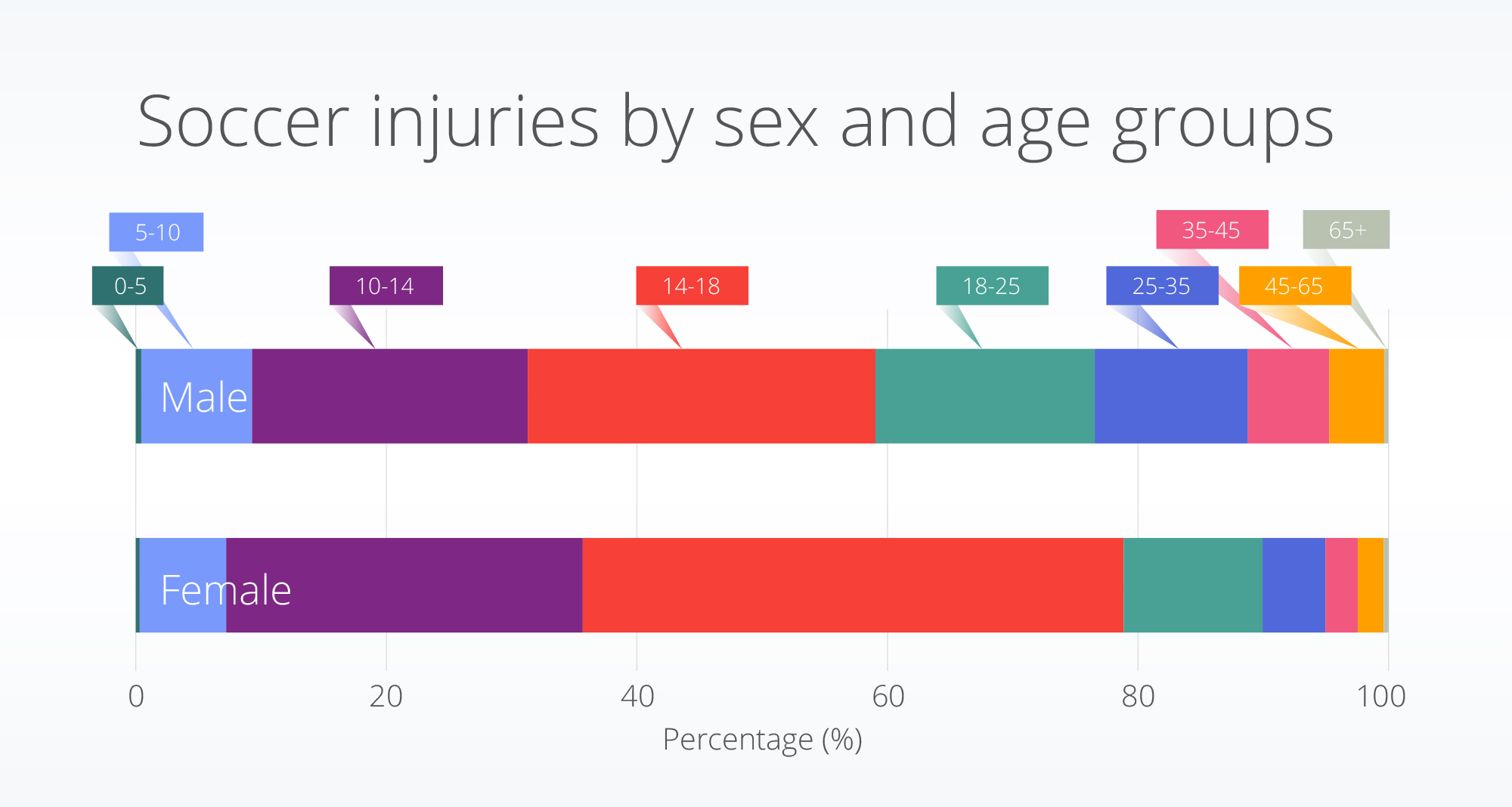
When people had soccer-related injuries, did they go to the emergency department?
Nearly 80% of soccer injuries resulted in emergency room encounters. Over 2.4% of the encounters were inpatient encounters, which may indicate more severe injuries.
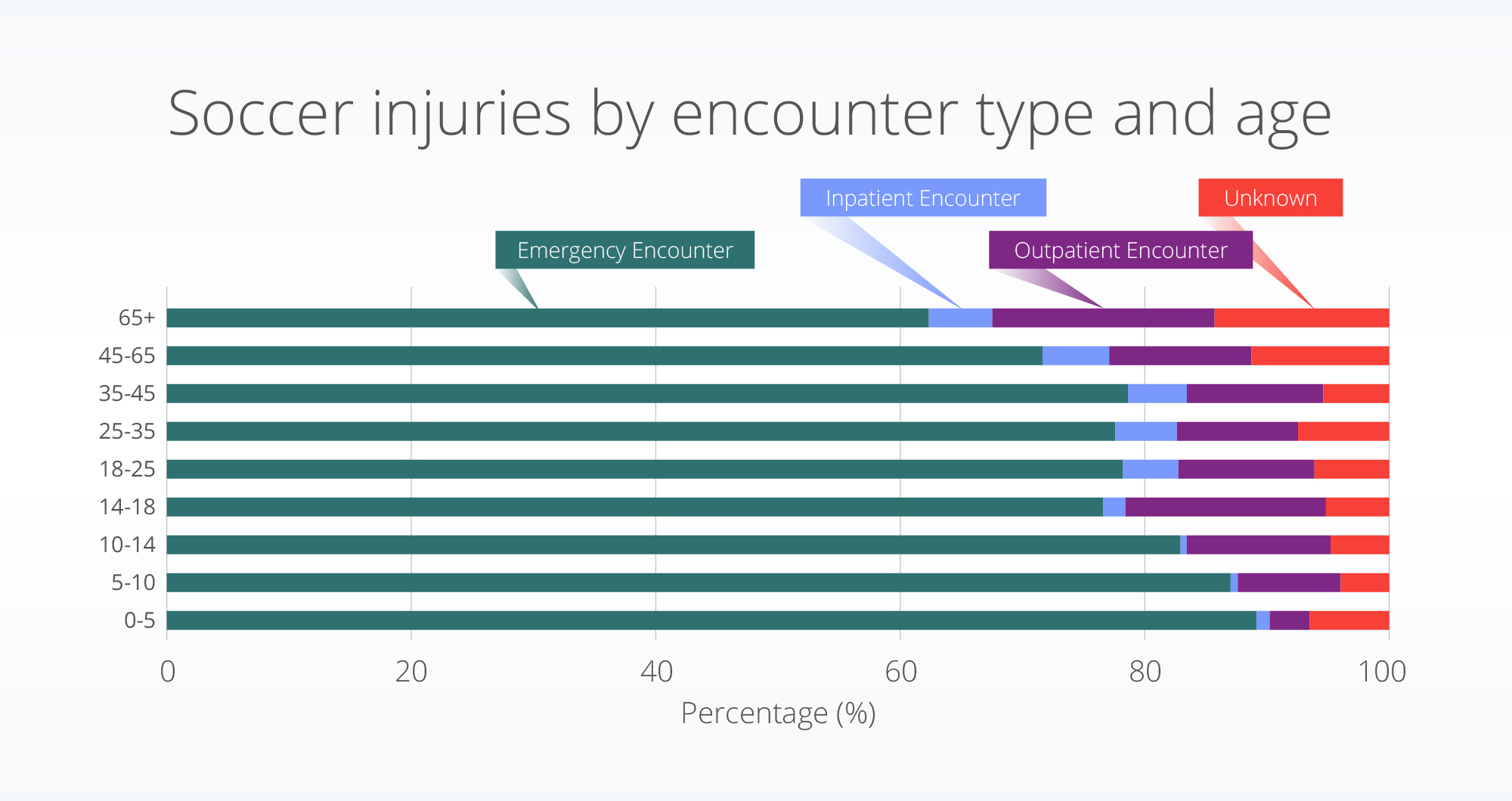
Which body part is injured?
Although soccer-related injuries affected the lower extremity most commonly (37.8%), the upper extremities, such as the shoulder, wrist or fingers, were the second most common affected body part (23.1%). When we look at only inpatient encounters, we found over 75% of the injuries included the lower extremity.
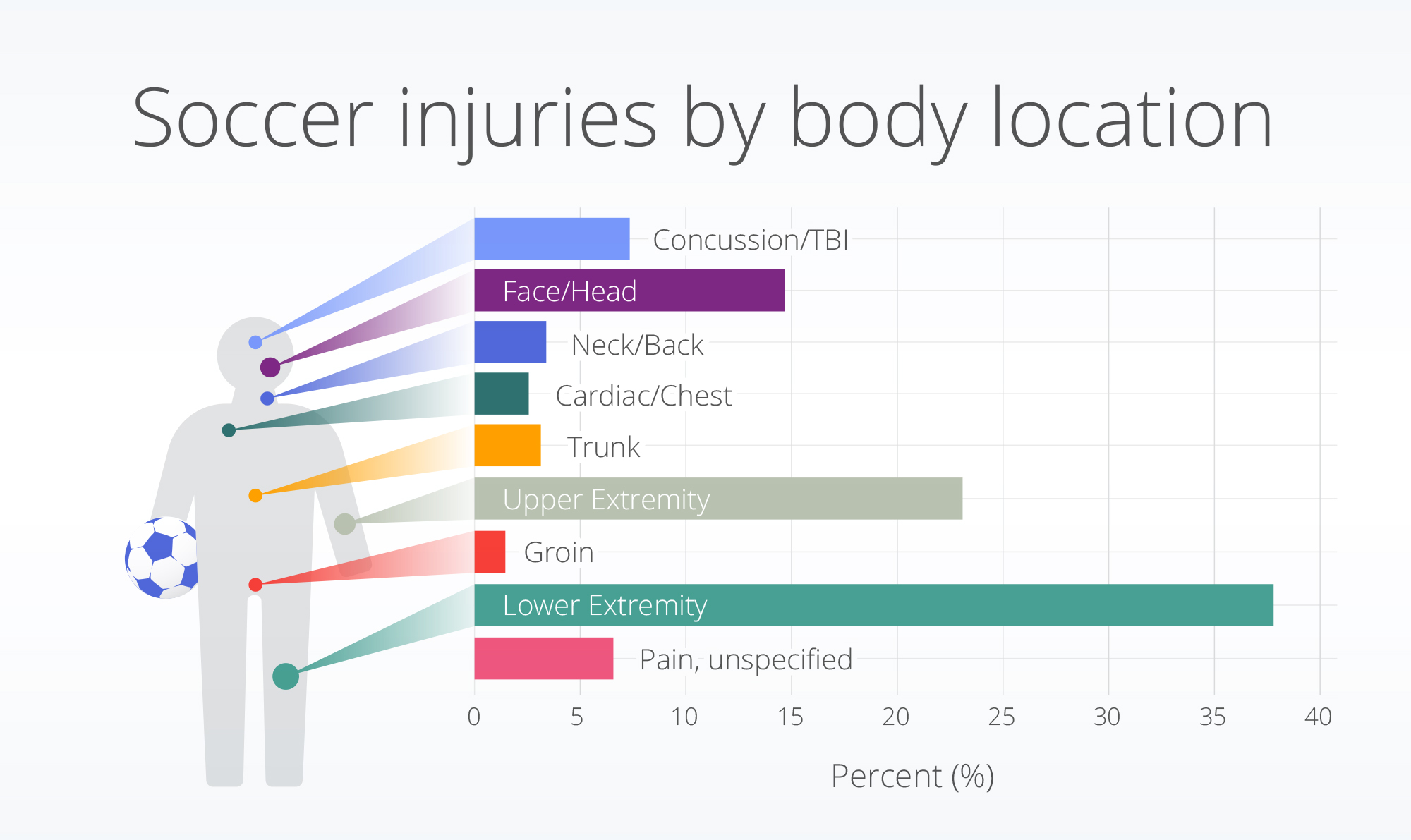
There is variation by age and sex in the percentage of soccer-related injuries that were concussions/TBIs. The 14-18 age group had the highest percentage of concussion/TBI injuries (11.7%). A higher percentage of the female injuries were made up of concussions/TBIs compared to the male population. Less than 1% of the concussions in female soccer athletes resulted in an inpatient encounter; most concussion encounters were emergency room encounters (56.7%) and outpatient encounters (34.1%).
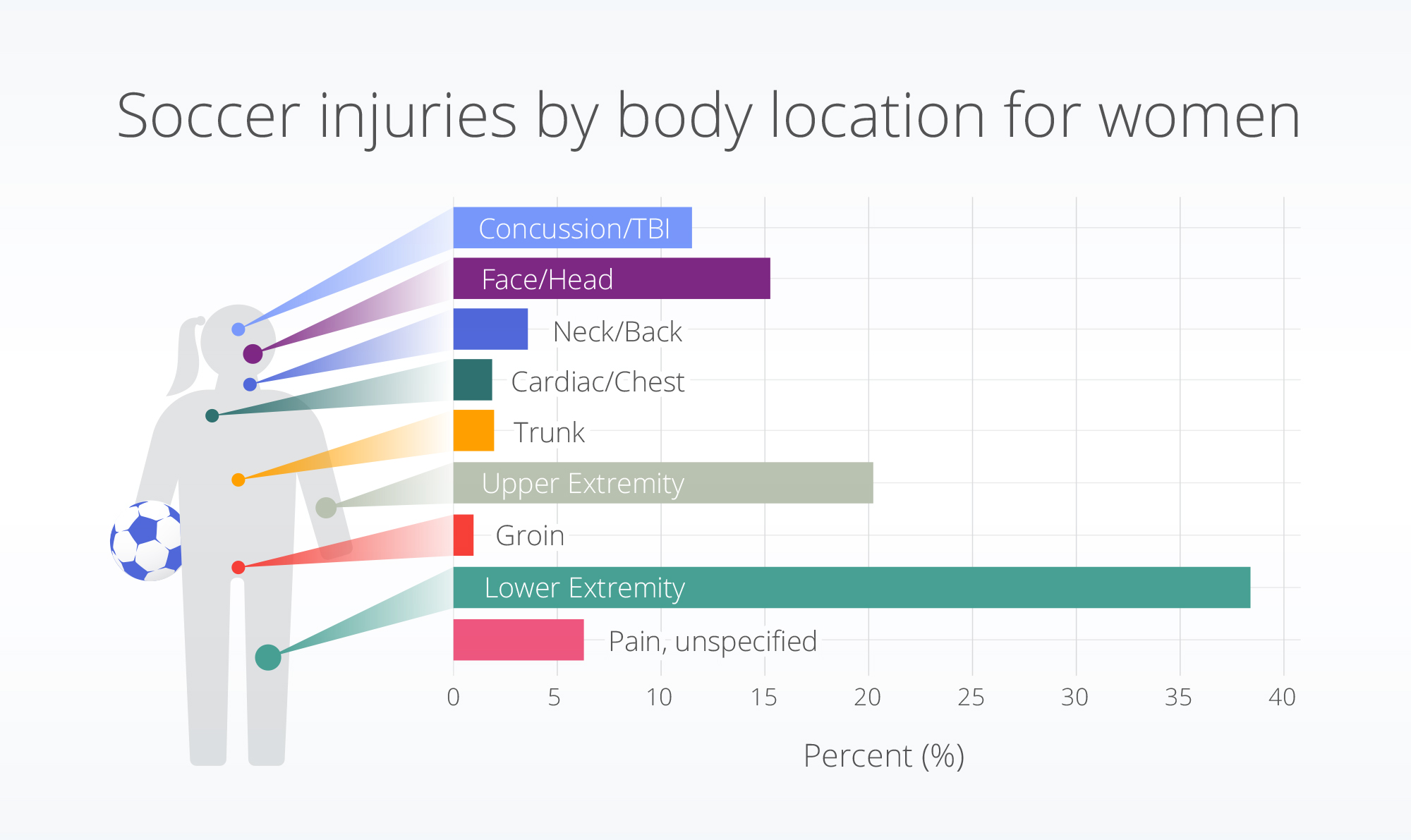
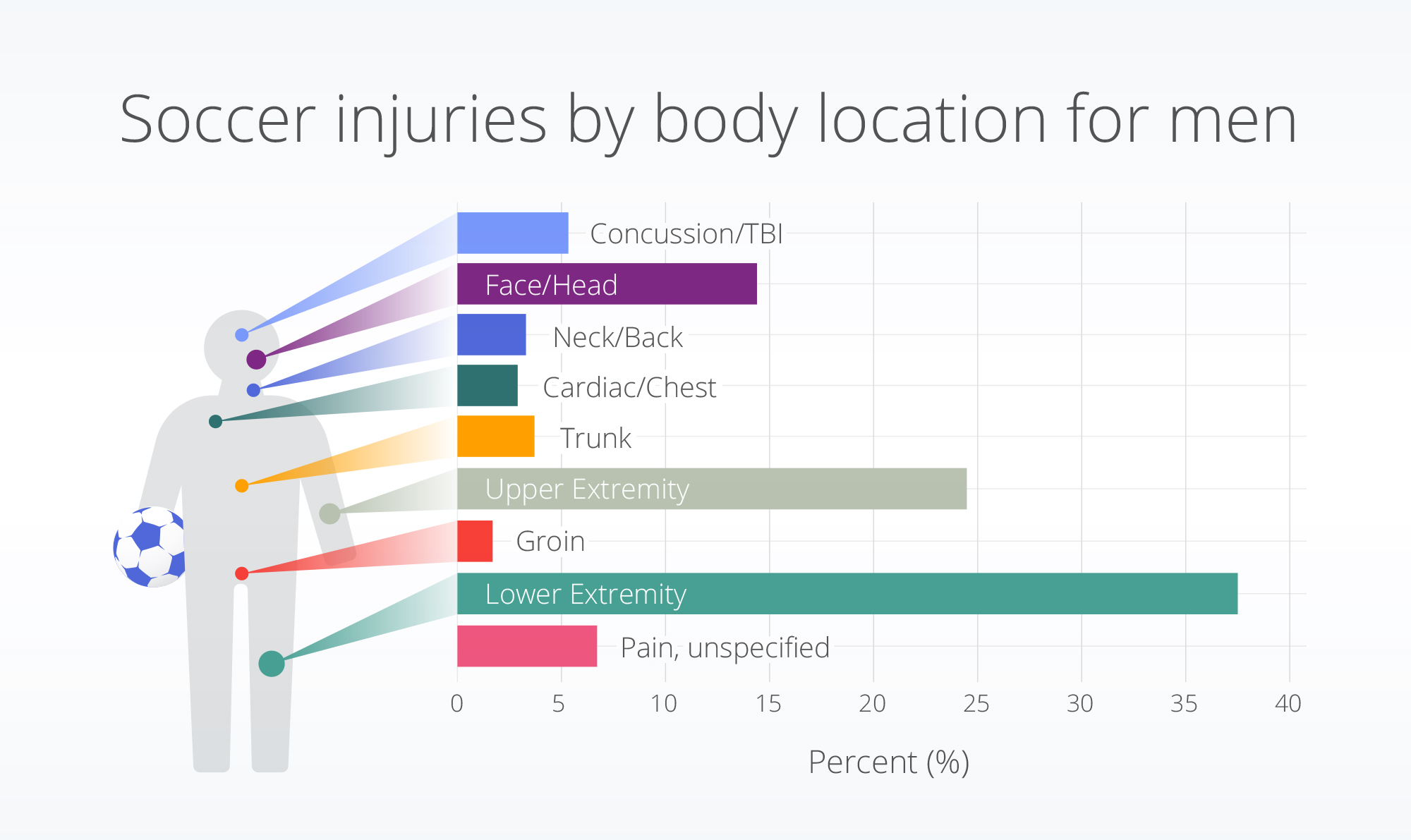
Within each age group, the rate of injuries to the neck and back also increased with age.
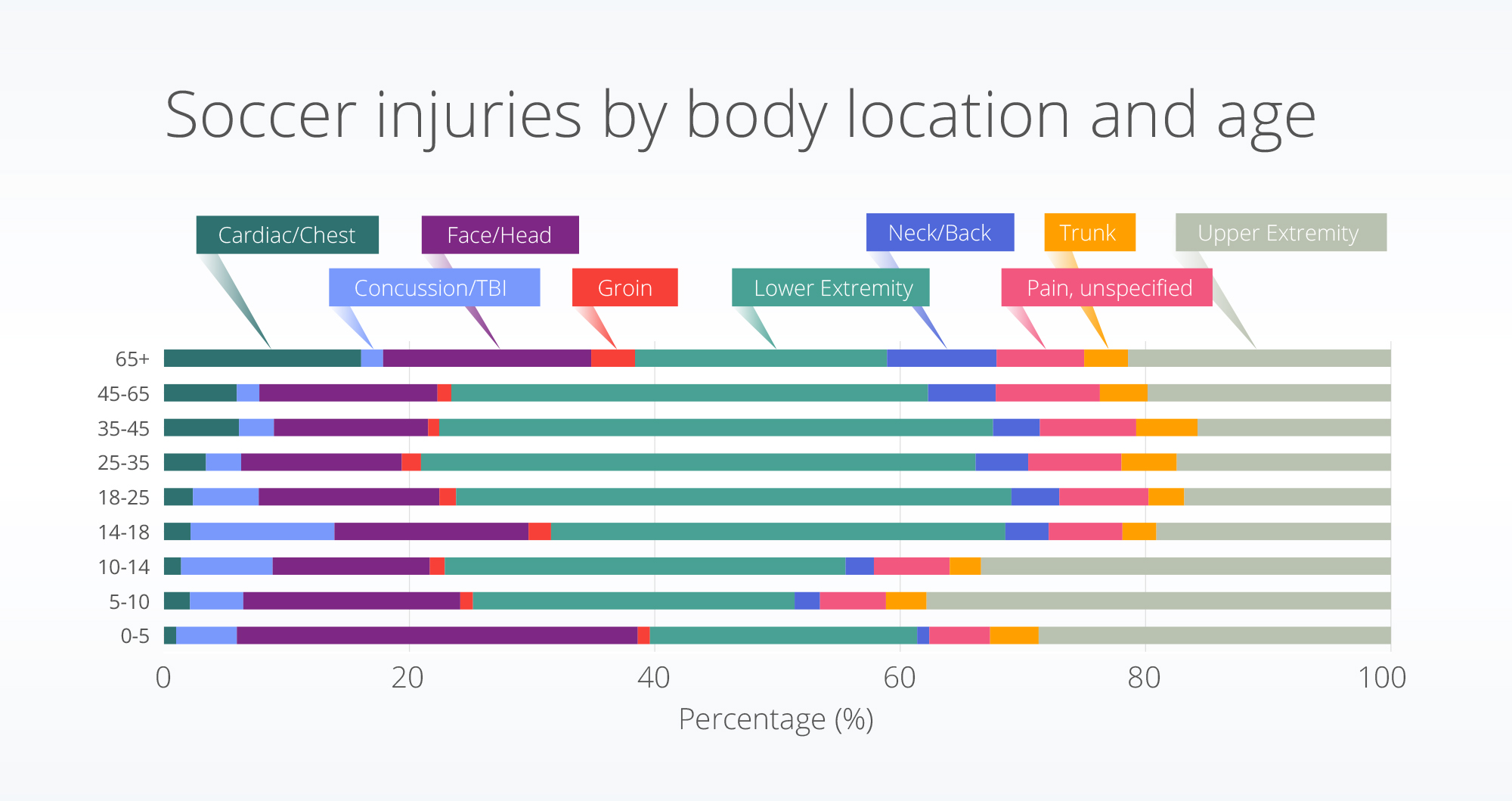
Discussion
Soccer is the most popular sport in the world with over 4 billion fans and 150 million registered athletes in the US (FIFA, 2023; SportyTell Editors, 2023). With any activity and especially one in which so many players participate, injuries are inevitable. This report gives an interesting look into the demographics of who is experiencing injuries and what body parts are most affected.
Other reports have reported that upper extremity injuries are a small percentage of injuries for non-goalkeepers (Marom & Williams III, 2018). It would be interesting to understand the people who are getting upper extremity injuries in our data, the severity of the injury, and detailed granularity of the exact part of the upper extremity that was injured (i.e., shoulder, wrist, finger, etc.). Digging into this granularity in combination with the age, sex, and position of the player may help to uncover additional patterns of injuries.
The lower extremity contributes to a high rate of overall injuries and inpatient injuries; 40% of emergency room admissions for soccer-related injuries for 15-19-year-olds involved injury to the ankle or knee (Adams & Schiff, 2006). Our data may showcase something similar where more than 75% of the inpatient encounters are related to the lower extremity. Surgeries to repair the ACL and other injuries to the ligaments of the knee likely contribute to the high percentage of inpatient lower extremity encounters.
These data showing a higher percentage of female soccer-related injuries involving concussions/TBIs than male soccer-related injuries is consistent with previous literature (Bretzin et al., 2021; Dick, 2009). Many researchers are digging into why this may be the case, and many theories exist (Sanderson, 2021). It is encouraging that immediately following the concussion/TBI, less than 1% of the encounters turned into inpatient hospital admissions. More research is needed to understand the severity of these injuries and the long-term effects.
There are limitations associated with this analysis. First, to be counted as a soccer-related injury, the person had to have an encounter within the hospital. Injuries that didn’t include a hospital visit would not be captured in our analysis. Further, multiple body parts could be included for one person/injury. To account for this, we counted each body part that was injured but did not look across different injury combinations. Additionally, we classified soccer-related injuries based on the existence of a subset of ICD-10 codes related to soccer. If a physician did not use these codes, the injury would not be captured within these data. Finally, no statistical analyses were conducted to test for differences between groups or account of the population who was playing soccer. In this study, we describe the differences within a population with soccer-related injuries, but additional research is needed to take into account the incidence amongst a population who plays soccer and test for significance.
In this analysis, we explored sex differences in concussions; we’re curious to continue to explore another sport with a high rate of concussions in an upcoming blog about American football. We’ll also soon be sharing injuries related to baseball and softball as the Major League Baseball season kicks off. We’ll then wrap up the series sharing how all these injuries compare across the different sports.
These are preliminary research findings and not peer reviewed. Data are constantly changing and updating. These findings are consistent with data pulled January 11, 2023.
References
Adams, A. L., & Schiff, M. A. (2006). Childhood Soccer Injuries Treated in U.S. Emergency Departments. Academic Emergency Medicine, 13(5), 571–574. https://doi.org/10.1197/j.aem.2005.12.015
Bretzin, A. C., Covassin, T., Wiebe, D. J., & Stewart, W. (2021). Association of Sex With Adolescent Soccer Concussion Incidence and Characteristics. JAMA Network Open, 4(4), e218191. https://doi.org/10.1001/jamanetworkopen.2021.8191
Dick, R. W. (2009). Is there a gender difference in concussion incidence and outcomes? British Journal of Sports Medicine, 43(Suppl_1), i46–i50. https://doi.org/10.1136/bjsm.2009.058172
Ekstrand, J., & Gillquist, J. (1983). Soccer injuries and their mechanisms: A prospective study. Medicine & Science in Sports & Exercise, 15(3), 267. https://doi.org/10.1249/00005768-198315030-00014
FIFA. (2023). FIFA — SOCCER’S WORLD GOVERNING BODY. https://www.ussoccer.com/history/organizational-structure/fifa
Hanson, D., Hanson, J., Vardon, P., McFarlane, K., Lloyd, J., Muller, R., & Durrheim, D. (2005). The injury iceberg: An ecological approach to planning sustainable community safety interventions. Health Promotion Journal of Australia, 16(1), 5–10. https://doi.org/10.1071/HE05005
Harmon, K. J., Proescholdbell, S. K., Register-Mihalik, J., Richardson, D. B., Waller, A. E., & Marshall, S. W. (2018). Characteristics of sports and recreation-related emergency department visits among school-age children and youth in North Carolina, 2010–2014. Injury Epidemiology, 5(1), 23. https://doi.org/10.1186/s40621-018-0152-0
Junge, A., & Dvorak, J. (2004). Soccer Injuries: A Review on Incidence and Prevention. Sports Medicine, 34(13), 929–938. https://doi.org/10.2165/00007256-200434130-00004
Marom, N., & Williams III, R. J. (2018). Upper Extremity Injuries in Soccer. American Journal of Orthopedics, 47(10). https://doi.org/10.12788/ajo.2018.0091
Sanderson, K. (2021, August 3). Why sports concussions are worse for women. https://www.nature.com/articles/d41586-021-02089-2
Smith, C. (2023). How Many Soccer Players In The World? https://soccerprime.com/how-many-soccer-players-in-the-world/
SportyTell Editors. (2023, January 7). Top-10 Most Popular Sports In The World 2023. SportyTell. https://sportytell.com/sports/most-popular-sports-world/
